
|   |

|   |
Jugalbandi Festival - Veejay Sai e-mail: vs.veejaysai@gmail.com Photos courtesy: Usha RK August 30, 2013 Dance jugalbandis have become more common than of their musical counterparts, of late. One of the big reasons for that is a solo show’s inability to find proper venues, sponsors and audiences. The bigger reason is many soloists think ‘safety in groups’ is a good policy. The sheer number of dancers growing in every city has also forced many organizers to group them and present them as and when festivals come by. Unlike that, in Bangalore, the new trend seems to be to create festivals with some meaningful content and put together performances that also challenge the dancers, musicians and give an overall experience to the rasikas. Arts promoter Usha RK, who in the past has curated many unique festivals of dance, came up with yet another one. This time the concept of ‘Jugalbandi’ was explored beyond the regular. The three-day festival from Aug 22 – 24, 2013 conducted at the Bangalore Gayana Samaj had the century old venue packed with rasikas. It is interesting to note that for the longest time, the garden city’s oldest cultural venue shut its doors to dance performances. They did have some veteran dancers (Mysore Venkatalakshamma and Maya Rao) to preside over their annual music conferences, but never let out the venue as such to dance festivals. It was only recently and once again due to the efforts made by Usha and under the presidentship of Mr. Prasad, that they welcomed dance festivals too. Day 1: Old wine in a sparkling new bottle The first evening opened with a unique jugalbandi between Bangalore’s very own Bharatanatyam dancer Sathyanarayana Raju and Kuchipudi dancer Ajay Kumar from Vijayawada. The interesting part was both the dancers presenting the famous ‘Bhamakalaapam’, each sticking to their own dance form. After a quick Pushpanjali, Ajay opened with the ‘Pravesha Daruvu’ of Satyabhama. The first thing that strikes you about Ajay is his effortless poise and the sowkhyam with which he presents this much hailed piece. It was a sheer pleasure to listen to the opening lines “Bhamane Satyabhamane” after a really long gap of time in the city. 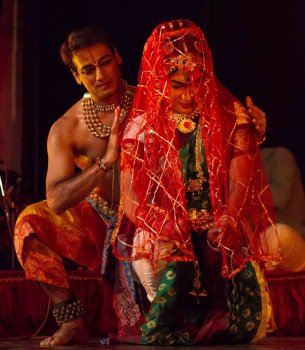
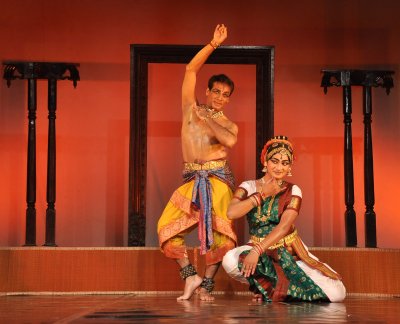
After the ‘Pravesha Daruvu’, Ajay continued into the act of ‘Ranguga Naa Meda’ where Satyabhama is imagining her marriage with Krishna. This particular excerpt has become a rarity even among Kuchipudi dancers. Most times, this is overlooked from the other popular acts in the opera. Ajay’s abhinayam as Bhama was exceptional. She ends that act with the famous ‘Lekha,’ the letter she writes to Krishna. The beauty of the Telugu language was worth seeing in Ajay’s highly theatrical Vaachikaabhinayam, one of the trademarks of Kuchipudi. The second part of the performance was the entry of Krishna. As Sathyanarayana Raju entered to ‘Raajeevaakshudu Raajagopaludu’ set to ragam Reetigowla as Lord Rajagopala, the dynamics between the two dancers was noteworthy. Nitish on flute was timely by venturing into ‘Yentha Muddo, Yentha Sogaso’ in Bindumalini as Krishna taunts the tantrum throwing Bhama. As Krishna asks Bhama ‘Kopamelane,’ the tenderness of the ragam Kuntalavaraali came through in Vasudha’s singing, even as Prarthana went off-notes at several points. Towards the end at a point of divine reconciliation of Krishna and Bhama, both the dancers displayed their technical virtuosity. Shakuntala Prabhat’s powerful nattuvangam paired with Srinivas’s for the Kuchipudi held the dance sequences together along with Gurumurthy’s mridangam. The jugalbandi ended with a Thillana in ragam Brindavana Saranga composed by Dr. Mangalampalli Balamurali Krishna. Ajay Kumar is easily one of the more promising youngsters around to take the fading Kuchipudi legacy on. Bangalore rasikas must thank Usha for inviting him to be a part of this festival. Day 2: What do divine housewives do? The second day of the festival was a jugalbandi between Odissi by Sharmila Mukherjii and Bharatanatyam by Soundarya Srivatsa. After a Pushpanjali and an invocation to Lord Ganesha, they performed a Kali Koutuvam set to Mishrachaapu talam. With great control over laya, Soundarya displayed her artistry. Sharmila took a while to warm up. It was only by the second half of the ‘Pallavi’ that one could see her get into form. 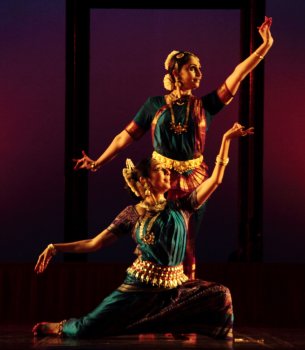
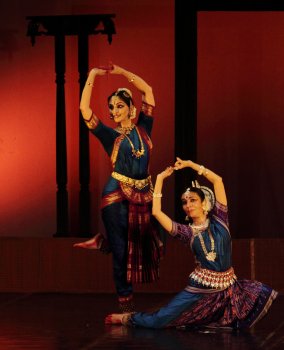
It was interesting to observe the patterns of the footwork juxtaposed by the talam patterns. One wished Sharmila had slowed down a bit to do more justice to the poetic grace of Odissi. She seemed to be in a hurry with her footwork at times. However by the second half of the Pallavi, the softer Odissi movement found a safe place in the sturdy clean geometry of Soundarya’s Bharatanatyam. The next in the line up was something unique; a dialogue between Lakshmi and Parvathi as to whose husband is greater. Choreographed to a Nindastuti by Saint Purandhara Dasa and set to a Ragamalika and a Talamalika, this piece stood out for its innovation. First, the divine housewives begin with a mutual admiration club before they get into a domestic brawl in the heavens. While Parvathi teases Lakshmi for having a husband who took ten incarnations, Lakshmi retorts by teasing Shiva as someone who goes around like a begging mendicant. The dramatic element got highlighted when Soundarya’s mascara started dripping across her face in streams of black down her cheeks. In the end, both the ladies realize their husbands are one in their divinity and reconcile. Sharmila and Soundarya were excellent in their abhinayam doing justice to their respective roles. Ganesh Hedge on the vocals with Srinivas on the sitar gave some melodious musical support to the dancers. Kishore Ghosh on mardala suited Sharmila’s temperament through the performance. Sharmila and Soundarya ended their jugalbandi with a Tarana in raag Nat Bhairav composed by the late Pt Ravi Shankar. While some of the ideas about this jugalbandi were fine, this would work better if each of the dancers took time to understand each other’s artistic needs to brew together a collaborative effort. This can certainly be reworked into a better product. Day 3: A messy melange The last and final day of the festival saw a jugalbandi between Bharatanatyam by Poornima Ashok and Kathak by Tushar Bhatt. Their opening with a very picturesque frieze as Shiva and Parvathi to the famous ‘Vaagarthaviasamprukthau’ from Kalidasa’s ‘Raghuvamsam’ heightened one’s expectations before they got into the ‘Maheshwara Sutras.’ The slow choreography of the short but well-picked piece was to heighten the mood. However, it didn’t show in the following Jatiswaram they chose. Set to ragam Kalyani and adi talam and sung by Raghunandan, the Carnatic music was meant to be balanced out by the raag Yaman sung by Hindustani guitarist turned vocalist Prakash Sontakke. While Poornima’s footwork was in place, it took a while for Tushar to catch up to her tempo. Added to this was the high-speed bols Pooja Bhat narrated to which Tushar had to once again keep up his speed. What could have been a wonderful jugalbandi was turning chaotic. At every other time, both the dancers had severe problems matching their footwork. Though Poornima warmed up only towards the end of the Jatiswaram, Tushar’s dance didn’t manage to catch up. 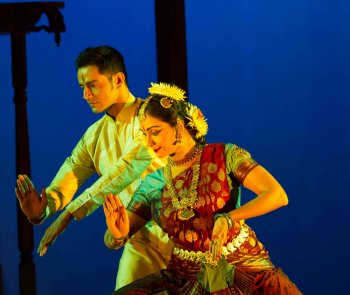
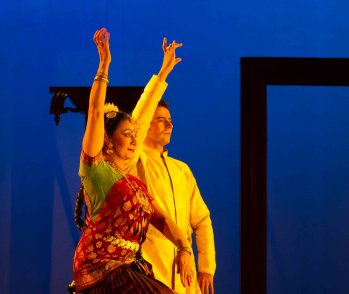
They continued into Adi Shankara’s ‘Ardhanareeshwara Stotram’ after that. Both the dancers looked distracted with Tushar visibly whispering into Poornima’s direction to get their symmetry in place. Added to the confusing choreography was the total detachment of the musicians from the dancers. Prakash is a brilliant singer, the show revealed. Unfortunately, singing for dance requires more than a baritone voice. One could see him deeply immersed into the song and with his eyes closed crooning away, unmindful of the fact that he was there on stage to sing for Tushar’s dance. Both the singers got into their own musical mood swings, which were completely cut off from what the dancers were doing on stage. Tabla by Ajay Kumar Singh and sitar by Ashok Iyengar was good on its own side, except it never came close to the dancer’s movements. At one point, Pooja had to forcibly direct the sitar player to get him back to track to suit the choreography of the dance. Their performance ended with a Thillana in raag Kalavati before they finished it with an Abhang. Where was the jugalbandi, one had to ask. The musicians didn’t match with the dancers, who in turn didn’t match with each other. Hopefully they will rectify that for another time. Special mention must be made of Sai Venkatesh whose lighting on all the three evenings was outstanding. He made each and every frame look complete with his lighting technique. It is important for the growth of the dance scene as such to come up with these sorts of performances and themed festivals, which enable dancers to stretch their limits beyond the usual and deliver their optimum. The Jugalbandi Festival was certainly one of its kind, a risky experiment to put up. One must commend Usha RK for this bold gesture. Veejay Sai is a writer, editor and a culture critic. |